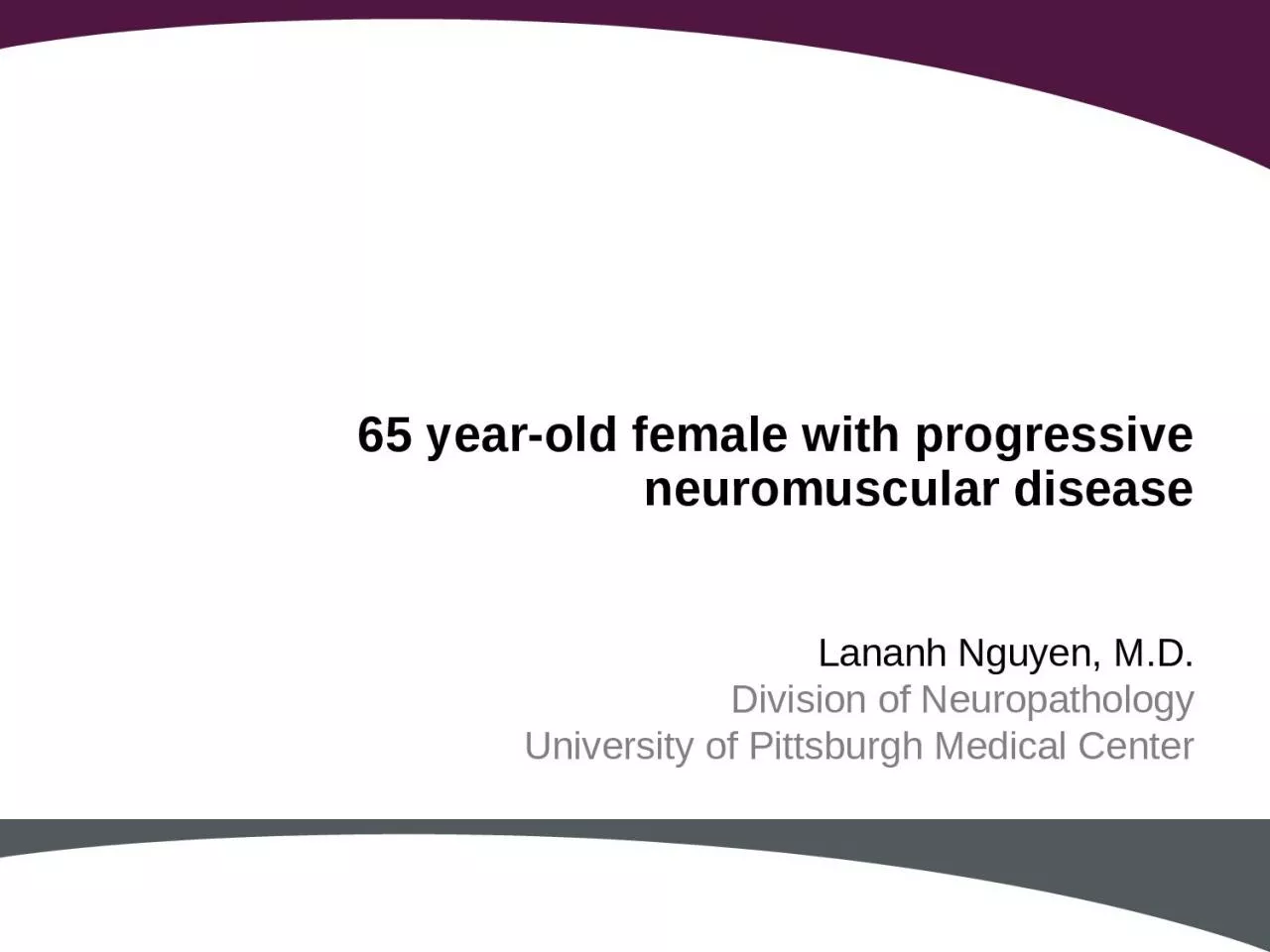

Lananh Nguyen MD Division of Neuropathology University of Pittsburgh Medical Center 65 year old male presents with 12 years of intermittent muscle cramping and twitching He has had unsteadiness on his feet and difficulty maintaining his posture at times due to weakness and states he trips o ID: 929819
Download Presentation The PPT/PDF document "65 year-old female with progressive neur..." is the property of its rightful owner. Permission is granted to download and print the materials on this web site for personal, non-commercial use only, and to display it on your personal computer provided you do not modify the materials and that you retain all copyright notices contained in the materials. By downloading content from our website, you accept the terms of this agreement.
Slide1
65 year-old female with progressive neuromuscular disease
Lananh Nguyen, M.D.
Division of Neuropathology
University of Pittsburgh Medical Center
Slide265 year old male presents with 1-2 years of intermittent muscle cramping and twitching. He has had unsteadiness on his feet and difficulty maintaining his posture at times due to weakness and states he trips over things occasionally as well. He has also noticed in the past year that his hands are not as strong as they used to be and he needs help at times opening jars and other previously menial tasks. 3 months ago he began to require the use of a cane and was sent to a neurologist by his PCP.2
Slide3Physical Exam revealed Cranial nerves appear intactMentation appropriate Bilateral lower extremity atrophy greater than upper extremity with wasting of his gastrocnemius to be the most severe.Upper extremity spasticityHyporeflexive in all 4 extremitiesTongue fasiculations 3
Slide4He was then sent for EMG testingNormal sensory nerve action potentials (SNAP)Very mildly reduced compound muscle action potentials (CMAP)Normal F-wave latencies Increased amplitude, duration and polyphasia of motor unit potentials with signs of decreased recruitmentBoth fibrillations and fasciculations seen in upper and lower extremitiesTongue fasciculations on needle EMG present
4
Slide5MRI Brain Age related white matter changes with no signs of atrophy or previous strokeMRI Cervical SpineMild right lateral disc bulge C4-C5 with no intrusion of the nerve root or spinal canalLumbar Puncture revealed no significant abnormalities except increased glutamate levelsHe developed PNA and sepsis and passed away 5 months later5
Slide6The thoracic, cervical, and lumbosacral anterior horns were atrophicThe lower extremity muscles showed severe atrophy and the upper extremity muscles showed moderate atrophyAn autopsy was performed and showed the following:6
Slide7Click here for a normal muscleThis is a frozen section of the muscle. Describe what you see.
Slide8H&E of the quadriceps muscle showing end-stage muscle demonstrated by severe panfascicular atrophy, variation in myofiber sizes, grouped fiber atrophy and increased nuclear clumps.This is a frozen section of the lower extremity muscle. Describe what you see.
Slide9This is a section of the spinal cord anterior horn. What do you see?
This is normal
Slide10H&E stain of the gray matter in the spinal cord shows a prominent loss of motor neurons in a background of reactive glial cells (arrows). This is a section of the spinal cord anterior horn. What do you see?
Slide11This is a section of the spinal cord anterior horn. What do you see?
Slide12There are a few remaining motor neurons in the anterior horn. Present within the cytoplasm are eosinophilic inclusions called Bunina bodies (arrows). This is a section to the spinal cord anterior horn. What do you see?
Slide13What is the diagnosis?
Slide14What is the diagnosis? Amyotrophic lateral sclerosis (ALS)aka Lou-Gehrig’s disease
Slide15ALSSporadic- 80-90% of casesGenetic testing has increased in recent years with various markers found (see next slides)Many genetic markers correlate with both ALS and FTD- further research to investigate this link is underwaySurvival average 3 years from diagnosis Bulbar onset has worse prognosis
Treatment is supportive
Riluzole
- prolongs survival by 6 months
Slide1616
Gene
Location
Inheritance
Percentage explained
Putative protein function
Familial ALS
Sporadic ALS
Values represent the percentage of ALS explained by each gene in populations of European ancestry. References are provided in the main text. AD, autosomal dominant; AR, autosomal recessive; XD, X-linked dominant; DENN, differentially expressed in normal and neoplasia.
TARDBP
1p36
AD
4
1
RNA metabolism
SQSTM1
5q35
AD
1
<1
Ubiquitination; autophagy
C9ORF72
9p21
AD
40
7
DENN protein
VCP
9p13
AD
1
1
Proteasome; vesicle trafficking
OPTN
10p13
AR and AD
<1
<1
Vesicle trafficking
FUS
16p11
AD and AR
4
1
RNA metabolism
PFN1
17p13
AD
<1
<1
Cytoskeletal dynamics
SOD1
21q22
AD and AR
12
1–2
Superoxide metabolism
UBQLN2
Xp11
XD
<1
<1
Proteasome
Table 1: Genes known to carry ALS-causing mutations
Slide1717
Slide18References18Alan E Renton, Adriano Chiò,Bryan J Traynor: State of play in amyotrophic lateral sclerosis genetics. Nature Neuroscience Volume: 17, Pages: 17–23. 26 December 2013.